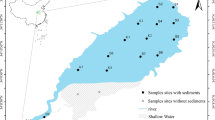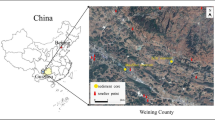Abstract
Previous investigations on heavy metals in the water–sediment compartment focused on their spatial distribution, and the influence of sediment pH and organic matter (OM) on metal environmental occurrences. However, there are limited studies on the effects of physicochemical properties on the migration and transformation of heavy metals in the water–sediment compartments. This study investigated the relationship between the physicochemical properties of sediments and the distribution and chemical speciation of heavy metals, and the potential environmental risk of heavy metals in water and sediment using Risk Assessment Code (RAC) values and the Tessier five-step extraction method. Adsorption and desorption experiments showed that the sediment had weak adsorption and the strongest desorption capacity for Cd. Results of the pH, OM, surface element content, and X-ray diffraction (XRD) patterns suggested that cadmium (Cd) was more likely to partition into the water phase from the sediment during the flooding and water storage periods. When pH was 7–8 and OM content was 3.6–5.9%, the sediment–water distribution coefficient of Cd was low due to its large ionic radius, and the surface adsorption sites were saturated by other elements. These studies can provide a theoretical basis for the management and pollution control of the Three Gorges Reservoir.








Similar content being viewed by others
Data availability
The data that support the findings of this study are available from the corresponding author, upon reasonable request.
References
Ao, L., Lei, B., Wang, Y., Zhou, X., & Zhang, S. (2014). Sediment risk assessment and heavy metal source analysis in typical country water level fluctuated zone (WLFZ) of the Three Gorges (in Chinese). Environmental Science, 35(1), 179–185. https://doi.org/10.13227/j.hjkx.2014.01.026
Bing, H., Zhou, J., Wu, Y., Wang, X., Sun, H., & Li, R. (2016). Current state, sources, and potential risk of heavy metals in sediments of Three Gorges Reservoir, China. Environmental Pollution, 214, 485–496. https://doi.org/10.1016/j.envpol.2016.04.062
Bing, H., Wu, Y., Zhou, J., Sun, H., Wang, X., & Zhu, H. (2019). Spatial variation of heavy metal contamination in the riparian sediments after two-year flow regulation in the Three Gorges Reservoir, China. Science of the Total Environment, 649, 1004–1016. https://doi.org/10.1016/j.scitotenv.2018.08.401
Castaldi, P., Santona, L., Enzo, S., & Melis, P. (2008). Sorption processes and XRD analysis of a natural zeolite exchanged with Pb(2+), Cd(2+) and Zn(2+) cations. Journal of Hazardous Materials, 156(1–3), 428–434. https://doi.org/10.1016/j.jhazmat.2007.12.040
Dong, J., Xia, X., Zhang, Z., Liu, Z., Zhang, X., & Li, H. (2018). Variations in concentrations and bioavailability of heavy metals in rivers caused by water conservancy projects: Insights from water regulation of the Xiaolangdi Reservoir in the Yellow River. Journal of Environmental Sciences, 74, 79–87. https://doi.org/10.1016/j.jes.2018.02.009
Fu, C., Lan, Q., Wu, Y., Yan, B., Ping, W., Huang, L., et al. (2020). Influence of sediment characteristics on heavy metal fraction distribution in the water-level fluctuation zone of the Three Gorges Reservoir Area, China. Water, Air, & Soil Pollution, 231(4), 175. https://doi.org/10.1007/s11270-020-04525-x
Guo, W. (2016). Study on heavy metals pollution of sediments in the Three Gorges Reservoir during its operating period with low water level (in Chinese). (D). North China University of Water Resources and Electric Power.
Harter, R. (1983). Effect of soil pH on adsorption of lead, copper, zinc, and nickel. Soil Science Society of America Journal, 47, 47–51. https://doi.org/10.2136/sssaj1983.03615995004700010009x
Helios-Rybicka, E., & Wójcik, R. (2012). Competitive sorption/desorption of Zn, Cd, Pb, Ni, Cu, and Cr by clay-bearing mining wastes. Applied Clay Science, 65–66, 6–13. https://doi.org/10.1016/j.clay.2012.06.006
Jia, X., Wang, C., Zeng, X., Yu, Z., Sheng, G., & Fu, J. (2014). The occurrence, accumulation and preliminary risk assessment of heavy metals in sediments from the main tributaries in the Three Gorges Reservoir (in Chinese). Geochimica, 43(2), 174–179. https://doi.org/10.19700/j.0379-1726.2014.02.009
Kayembe, J. M., Sivalingam, P., Salgado, C. D., Maliani, J., Ngelinkoto, P., Otamonga, J.-P., et al. (2018). Assessment of water quality and time accumulation of heavy metals in the sediments of tropical urban rivers: Case of Bumbu River and Kokolo Canal, Kinshasa City, Democratic Republic of the Congo. Journal of African Earth Sciences, 147, 536–543. https://doi.org/10.1016/j.jafrearsci.2018.07.016
Lan, Q., Yan, B., Zhang, H., Chen, L., Pan, J., & Fu, C. (2018). Contamination assessments and sources analysis of heavy metals in sendiments from water-level fluctuating zone along Wanzhou section, Three Gorges Reservoir Area (in Chinese). Environmental Engineering, 36(8),193–197. https://doi.org/10.13205/j.hjgc.201808038
Leng, Q., Cui, J., Zhou, F., Du, K., Zhang, L., Fu, C., et al. (2018). Wet-only deposition of atmospheric inorganic nitrogen and associated isotopic characteristics in a typical mountain area, southwestern China. Science of the Total Environment, 616–617, 55–63. https://doi.org/10.1016/j.scitotenv.2017.10.240
Liu, J., Lin, F., Shi, S., Ayi, Q., Liu, S., & Zeng, B. (2017). Effects of water level regulation on the seed germination and production of annual plant Xanthium sibiricum in the water-level-fluctuating-zone of Three Gorges Reservoir. Scientific Report, 7(1), 5056. https://doi.org/10.1038/s41598-017-04599-4
Lu, H., Wang, X., Yang, J., & Xie, Z. (2015). One-step synthesis of CDTA coated magnetic nanoparticles for selective removal of Cu(II) from aqueous solution. International Journal of Biological Macromolecules, 78, 209–214. https://doi.org/10.1016/j.ijbiomac.2015.03.065
Mali, M., Dell’Anna, M. M., Mastrorilli, P., Damiani, L., Ungaro, N., Belviso, C., et al. (2015). Are conventional statistical techniques exhaustive for defining metal background concentrations in harbour sediments? A case study: The Coastal Area of Bari (Southeast Italy). Chemosphere, 138, 708–717. https://doi.org/10.1016/j.chemosphere.2015.07.046
Melo, S. L., & Nipper, M. (2007). Sediment toxicity tests using the burrowing amphipod Tiburonella viscana (Amphipoda: Platyischnopidae). Ecotoxicology and Environmental Safety, 66(3), 412–420. https://doi.org/10.1016/j.ecoenv.2005.12.003
Pandit, P., Mangala, P., Saini, A., Bangotra, P., Kumar, V., Mehra, R., et al. (2020). Radiological and pollution risk assessments of terrestrial radionuclides and heavy metals in a mineralized zone of the siwalik region (India). Chemosphere, 254, 126857. https://doi.org/10.1016/j.chemosphere.2020.126857
Pathirana, C., Ziyath, A. M., Jinadasa, K., Egodawatta, P., Sarina, S., & Goonetilleke, A. (2019). Quantifying the influence of surface physico-chemical properties of biosorbents on heavy metal adsorption. Chemosphere, 234, 488–495. https://doi.org/10.1016/j.chemosphere.2019.06.074
Serrano, S., O’Day, P. A., Vlassopoulos, D., García-González, M. T., & Garrido, F. (2009). A surface complexation and ion exchange model of Pb and Cd competitive sorption on natural soils. Geochimica Et Cosmochimica Acta, 73(3), 543–558. https://doi.org/10.1016/j.gca.2008.11.018
Sijin, L., Yeyao, W., & Lihuan, H. (2014). Ecological risk of heavy metals on the paddy soils at a village in Hunan. Environmental Science & Technology, 37(12), 100–105. https://doi.org/10.3969/j.issn.1003-6504.2014.12.020
Sipos, P., Nemeth, T., Kis, V. K., & Mohai, I. (2008). Sorption of copper, zinc and lead on soil mineral phases. Chemosphere, 73(4), 461–469. https://doi.org/10.1016/j.chemosphere.2008.06.046
Sonthiphand, P., Cejudo, E., Schiff, S. L., & Neufeld, J. D. (2013). Wastewater effluent impacts ammonia-oxidizing prokaryotes of the Grand River, Canada. Applied and Environmental Microbiology, 79(23), 7454–7465. https://doi.org/10.1128/AEM.02202-13
Sticher, H. (1986). Long-term trend analysis of heavy metal content and translocation in soils. Geoderma, 38, 195–207. https://doi.org/10.1016/0016-7061(86)90015-7
Tahervand, S., & Jalali, M. (2017). Sorption and desorption of potentially toxic metals (Cd, Cu, Ni and Zn) by soil amended with bentonite, calcite and zeolite as a function of pH. Journal of Geochemical Exploration, 181, 148–159. https://doi.org/10.1016/j.gexplo.2017.07.005
Tessier, A., Campbell, P., & Bisson, M. (1979). Sequential extraction procedure for speciation of particulate tracemetals. American Chemical Society, 51(7), 844–851.
Wang, P., Liu, J., Wang, C., Qian, J., Hou, J., & Ren, L. (2014). Seasonal, spatial distribution and ecological risk assessment of heavy metals in surface sediments from a watershed area in Gonghu Bay in Taihu Lake, China. Terrestrial, Atmospheric and Oceanic Sciences, 25(4), 605. https://doi.org/10.3319/TAO.2014.02.17.01(Hy)
Yang, G., Zhang, G., & Wang, H. (2015). Current state of sludge production, management, treatment and disposal in China. Water Research, 78, 60–73. https://doi.org/10.1016/j.watres.2015.04.002
Ye, C., Li, S., Zhang, Y., & Zhang, Q. (2011). Assessing soil heavy metal pollution in the water-level-fluctuation zone of the Three Gorges Reservoir, China. Journal of Hazardous Materials, 191(1–3), 366–372. https://doi.org/10.1016/j.jhazmat.2011.04.090
Ye, C., Butler, O. M., Ming, Du., Liu, W., & Zhang, Q. (2019). Spatio-temporal dynamics, drivers and potential sources of heavy metal pollution in riparian soils along a 600kilometre stream gradient in Central China. Science of the Total Environment, 651(Pt 2), 1935–1945. https://doi.org/10.1016/j.scitotenv.2018.10.107
Zhang, L., Liu, Y., Qiao, B., Fu, C., Wang, H., & Huang, Y. (2016). Characteristics of atmospheric dry and wet deposition of trace metals in the hinterland of the Three Gorges Reservoir, China (in Chinese). Environmental Science, 37(2), 466–474. https://doi.org/10.13227/j.hjkx.2016.02.009
Zhu, H., Bing, H., Wu, Y., Zhou, J., Sun, H., Wang, J., et al. (2019). The spatial and vertical distribution of heavy metal contamination in sediments of the Three Gorges Reservoir determined by anti-seasonal flow regulation. Science of the Total Environment, 664, 79–88. https://doi.org/10.1016/j.scitotenv.2019.02.016
Funding
This work was supported by the National Natural Science Foundation of China (no. 31670467, 51808089), the Science and Technology Research Program of Chongqing Municipal Education Commission (grant no. KJZD-K201801202), and the Open Fundamental Theory Research Project of Chongqing Municipal Key Laboratory of Universities on Water Environment Evolution and Pollution Prevention in Three Gorges Reservoir Area (no. WEPKL2016LL-07).
Author information
Authors and Affiliations
Contributions
C. L. 1 and Q. L. wrote the manuscript. C. L. 2, J. W., and S. L. conducted experiments. B. Y. and Y. Z. analyzed the results, and H. W. prepared the figures and tables. C. F. and Y. W. revised the manuscript.
Corresponding authors
Ethics declarations
Ethics approval and consent to participate
Not applicable.
Conflict of interest
The authors declare no competing interests.
Additional information
Publisher's note
Springer Nature remains neutral with regard to jurisdictional claims in published maps and institutional affiliations.
Rights and permissions
Springer Nature or its licensor (e.g. a society or other partner) holds exclusive rights to this article under a publishing agreement with the author(s) or other rightsholder(s); author self-archiving of the accepted manuscript version of this article is solely governed by the terms of such publishing agreement and applicable law.
About this article
Cite this article
Liu, C., Lan, Q., Yan, B. et al. Spatio-temporal variation and hazard assessment of potentially toxic metal element contamination in sediments and water before and after a water-level fluctuation cycle in the Three Gorges Reservoir, Wanzhou, China. Environ Monit Assess 195, 920 (2023). https://doi.org/10.1007/s10661-023-11457-6
Received:
Accepted:
Published:
DOI: https://doi.org/10.1007/s10661-023-11457-6




